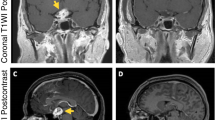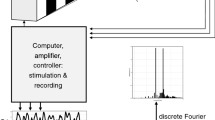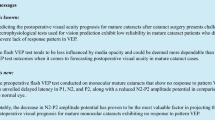Abstract
Flash visual evoked potentials (FVEPs) are often irreproducible during surgery. We assessed the relationship between intraoperative FVEP reproducibility and EEG amplitude. Left then right eyes were stimulated by goggle light emitting diodes, and FVEPs were recorded from Oz–Fz′ (International 10-20 system) in 12 patients. Low cut filters were ≤5 Hz in all patients; two patients also had recordings using 10 and 30 Hz. The reproducibility of FVEP and the amplitude of the concomitant EEG from C4′–Fz were measured. Nine patients had low amplitude EEG (<30 μV); reproducible FVEPs were obtained from all eyes with normal pre-operative vision. The other three patients had high amplitude EEG (>50 μV); FVEPs were absent from three of four eyes with normal pre-operative vision (the other normal eye had a present but irreproducible FVEP). Raising the low cut filter to 10 and 30 Hz (in two patients) progressively reduced EEG and FVEP amplitude, reduced amplifier blocking time and improved FVEP reproducibility. FVEPs were more reproducible in the presence of low amplitude EEG than high amplitude EEG. This is the first report describing the effect of EEG amplitude on FVEP reproducibility during surgery.






Similar content being viewed by others
References
Toleikis SC, Toleikis JR. VEP. In: Koht A, Sloan TB, Toleikis JR, editors. Monitoring the nervous system for anesthesiologists and other health care professionals. New York: Springer; 2012. p. 69–93.
Cedzich C, Schramm J. Monitoring of flash visual evoked potentials during neurosurgical operations. Int Anesthesiol Clin. 1990;28(3):165–9.
Wiedemayer H, Fauser B, Armbruster W, Gasser T, Stolke D. Visual evoked potentials for intraoperative monitoring using total intravenous anesthetic. J Neurosurg Anesthesiol. 2003;15:19–24.
Sebel PS, Intram DA, Flynn PJ, Rutherford CF, Rogers H. Evoked potentials during isoflurane anesthesia. Br J Anaesth. 1986;58:580–5.
Cedzich C, Schramm J, Fahlbusch R. Are flash-evoked visual potentials useful for intraoperative monitoring of visual pathway function? Neurosurgery. 1987;21:709–15.
American Electroencephalographic Society guidelines for intraoperative monitoring of sensory evoked potentials. J Clin Neurophysiol. 1987;4(4):397–416.
American Clinical Neurophysiology Society. Guideline 9B. Guidelines on visual evoked potentials. J Clin Neurophysiol. 2006;23(2):138–56.
Odom FV, Bach M, Brigell M, Holder GE, McCulloch DL, Tormene AP, Vaegan. ISCEV standard for clinical visual evoked potentials (2009 update). Doc Ophthalmol. 2010;120:111–9.
Tinker JH, Sharbrough FW, Michenfelder JD. Anterior shift of the dominant EEG rhythm during anesthesia in the java monkey: correlation with anesthetic potency. Anesthesiology. 1977;46:252–9.
Rampil IJ, Lockhart SH, Eger EI II, Yasuda N, Weiskopf RB, Cahalan MK. The electroencephalographic effects of desflurane in humans. Anesthesiology. 1991;74:434–9.
Murphy M, Bruno MA, Riedner BA, et al. Propofol anaesthesia and sleep: a high-density EEG study. Sleep. 2011;34(3):283–91.
Kodama K, Goto T, Sato A, Sakai K, Tanaka Y, Hongo K. Standard and limitation of intraoperative monitoring of the visual evoked potential. Acta Neurochir. 2010;152:643–8.
Sasaki T, Itakura T, Suzuki K, et al. Intraoperative monitoring of visual evoked potential: introduction of a clinically useful method. J Neurosurg. 2010;112:273–84.
Cohen BA, Baldwin ME. Visual-evoked potentials for intraoperative neurophysiology monitoring: another flash in the pan? J Clin Neurophysiol. 2011;28(6):599–601.
Nuwer MR, Dawson EG. Intraoperative evoked potential monitoring of the spinal cord. A restricted filter, scalp method during Harrington instrumentation for scoliosis. Clin Orthop. 1984;183:42–50.
American Clinical Neurophysiology Society. Guideline 11B (2009). Guidelines for intraoperative monitoring of sensory evoked potential. ACNS web site. www.acns.org/pdf/guidelines/Guideline-11B.pdf.
American Clinical Neurophysiology Society. Guideline 9D. Guidelines on short latency somatosensory evoked potentials. J Clin Neurophysiol. 2006;23(2):168–79.
Banoub M, Tetzlaff JE, Schubert A. Pharmacologic and physiologic influences affecting sensory evoked potentials: implications for perioperative monitoring. Anesthesiology. 2003;99(3):716–37.
Huotari AM, Koskinen M, Suominen K, Alahuhta S, Remes R, Hartikainen KM, Jäntti V. Evoked EEG patterns during burst suppression with propofol. Br J Anaesth. 2004;92(1):18–24.
Chi OZ, McCoy CL, Field C. Effects of fentanyl anesthesia on visual evoked potentials in humans. Anesthesiology. 1987;67(5):827–30.
You Y, Thie J, Klistorner A, Gupta VK, Graham SL. Normalization of visual evoked potentials using underlying electroencephalogram levels improves amplitude reproducibility in rats. IOVS. 2012;53(3):1473–8.
Zaarour C, Engelhardt T, Strantzas S, Pehora C, Lewis S, Crawford MW. Effect of low-dose ketamine on voltage requirement for transcranial electrical motor evoked potentials in children. Spine. 2007;32(22):E627–30.
Skuse NF, Burke D. Power spectrum and optimal filtering for visual evoked potentials to pattern reversal. Electroencephalogr Clin Neurophysiol. 1990;77:199–204.
Shaw NA. The effects of low-pass filtering on the flash visual evoked potential of the albino rat. J Neurosci Methods. 1992;44:233–40.
Ota T, Kawai K, Kamada K, Kin T, Saito N. Intraoperative monitoring of cortically recorded visual response for posterior visual pathway. J Neurosurg. 2010;112:285–94.
Conflict of interest
The authors have no conflict of interest and the FVEP studies were performed according to current Canadian laws.
Author information
Authors and Affiliations
Corresponding author
Rights and permissions
About this article
Cite this article
Houlden, D.A., Turgeon, C.A., Polis, T. et al. Intraoperative flash VEPs are reproducible in the presence of low amplitude EEG. J Clin Monit Comput 28, 275–285 (2014). https://doi.org/10.1007/s10877-013-9532-8
Received:
Accepted:
Published:
Issue Date:
DOI: https://doi.org/10.1007/s10877-013-9532-8




